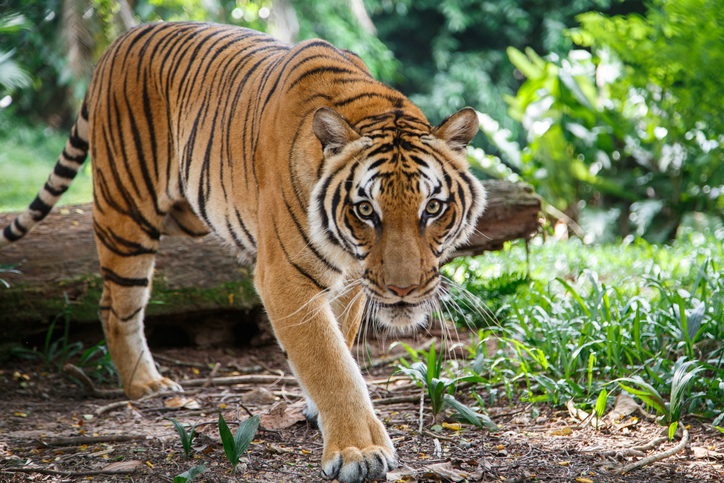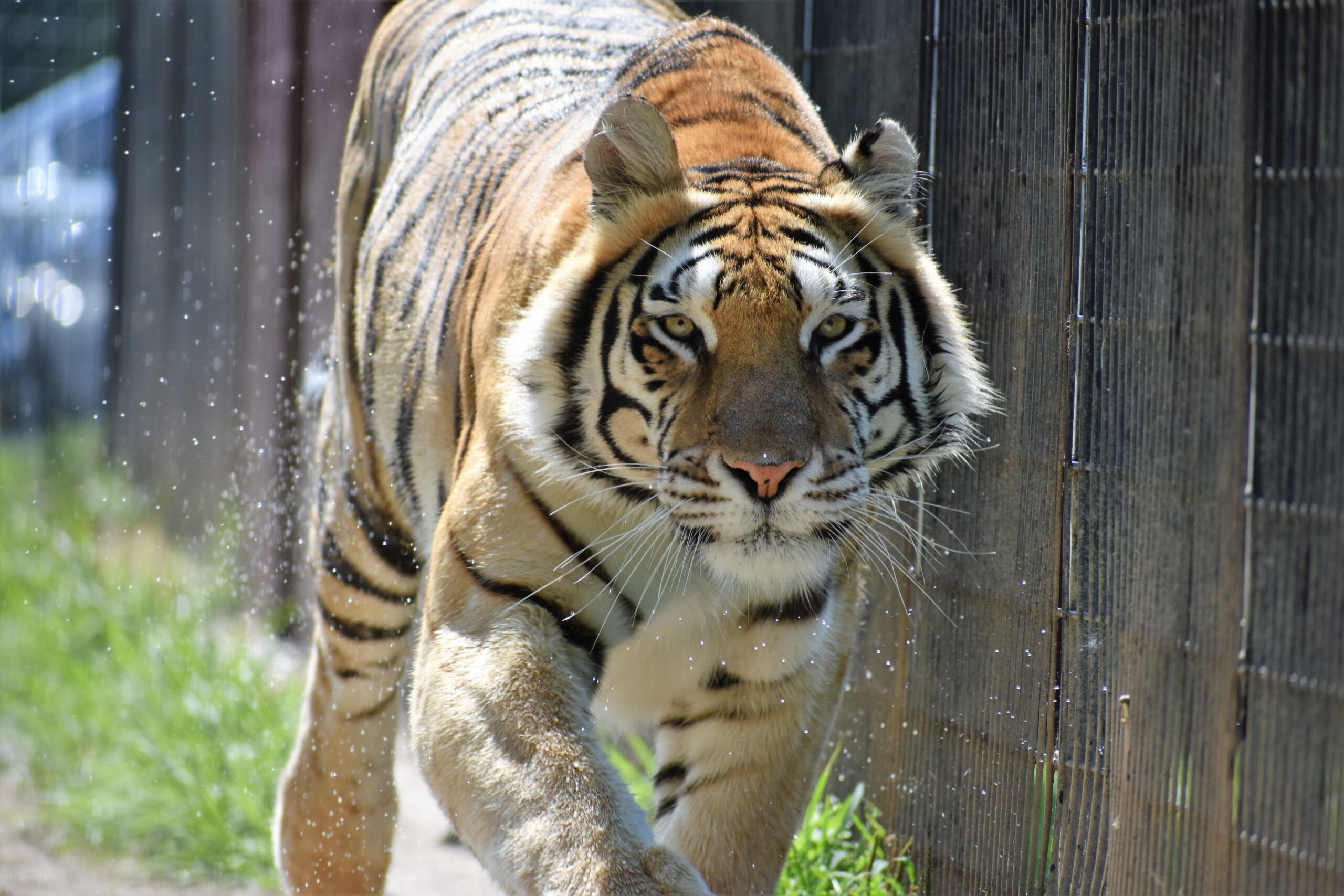
Meet Zahara at the Missouri Park
There is actually only one tiger species, but each type of tiger is considered a subspecies. A subspecies is a group within a species that is either physically or genetically different from the rest. There are nine subspecies or types of tigers, three of which are now extinct. The remaining six subspecies include the Bengal, Indo-Chinese, South China, Amur, and Sumatran tigers.
Tigers are one of the most awe-inspiring, courageous wild animals living today. The world’s largest cat species can be found in far east Russia, parts of North Korea, China, India, Southwest Asia and the Indonesian island of Sumatra. However, the human population has grown and encroached on tiger habitats, causing their territory to decrease. Pressure from habitat loss, illegal killing and shrinking food supply have pushed all species of tigers on to the endangered list.
Although no tigers are native to the United States, a few of these subspecies of tigers call Wild Animal Safari in Georgia and Missouri their home. Maybe that’s what makes it so special to see them up close. (Note: There are no tigers at the Texas safari park.)
While tigers can be identified by their signature stripes and powerful stature, not all of these big cats are the same. In fact, tiger stripe patterns are all as unique as a human fingerprint, no two are the same. Let’s take a closer look at each of them.
1. Bengal Tiger

The Bengal tiger (Panthera tigris tigris), also called the Indian tiger or the Royal Bengal tiger is native to the Indian subcontinent. Although it once roamed a much larger area, the Bengal is currently found in India, Bangladesh, Nepal and Bhutan.
The Bengal tiger is on the endangered list. It’s the most well-known breed of tiger and the largest tiger found in the wild. A male Bengal weighs between 397 and 569 pounds. The female is smaller, weighing between 220 and 350 pounds.
White Tiger

Meet me at the Georgia safari park!
If you’re lucky enough to see a white tiger, it may be an albino or the result of a genetic mutation. If it’s white with black stripes and has blue eyes, this coloration is caused by a genetic mutation called leucism and is specific to the Bengal tiger. Both parents must have the gene for a white cub to occur. It’s rare, however, only resulting in one out of 10,000 births.
An albino tiger, on the other hand, would be entirely white (no black stripes or very, very faint stripes) and have pink eyes.
Few white tigers survive in the wild because their white fur doesn’t provide any camouflage protection for the tiger.
2. Siberian Tiger

The Siberian tiger (Panthera tigris altaica), also known as the Manchurian tiger, Korean tiger, Amur tiger or Ussurian tiger, is an endangered species that lives in Northern Asia (China, Russia and Korea), although its territory was once much larger. Even though the Bengal tiger is larger in the wild, the Siberian tiger often grows to be larger than the Bengal in captivity, making it the largest purebred cat in the world.
Crossbreeds such as the liger, a mix between a female tiger and a male lion, get much larger than their parents, however. A full-grown male liger can weigh as much as 1600 pounds! That’s three times the size of a Bengal or Siberian tiger. When Bengals and Siberians are crossbred, they also become larger than their parents.
Although the heaviest Siberian tiger has a record of weighing 660 pounds, it’s typically smaller than the Bengal. Male Siberian tigers generally weigh between 389 and 475 pounds. Females typically weigh between 260 and 303 pounds.
The Siberian has a broad chest and large skull. Its thick fur, which protects it from the harsh winters of Northern Asia, tends to be a less vibrant color of orange than other tiger subspecies.
3. Sumatran Tiger

The Sumatran tiger (Panthera tigris sumatrae) is the smallest tiger subspecies and lives on the Indonesian island of Sumatra. Because it lives only on an island, it has been isolated from other tigers. This has resulted in genetics that are different from its “mainland” cousins. The Sumatran is a critically endangered species. Two other tiger subspecies, the Bali tiger and the Javan tiger, once occupied the same area but are now extinct.
The Sumatran tiger weighs approximately half that of the Bengal or Siberian. A male Sumatran tiger weighs between 220 and 310 pounds, whereas a female weighs between 165 and 243 pounds. Since the Sumatran is only slightly shorter than the Bengal or Siberian and weighs significantly less, it has a slight build compared to its bulkier cousins.
The stripes of the Sumatran are very dark and well-defined. They cover the tiger’s entire body, including its forelegs. Not all tigers have stripes on their front legs.
4. Indochinese Tiger

The Indochinese tiger (Panthera tigris corbetti), also known as Corbett’s tiger, is named in honor of the famous British hunter Jim Corbett who was often enlisted to hunt down man-eating tigers and leopards early in the 20th century.
The near critically endangered Indochinese tiger is native to Southeast Asia (China, Thailand, Laos, Burma and Vietnam). The illegal trade of tiger parts which are in high demand is the main reason for a quickly dwindling Indochinese tiger population. There are only around 300-400 Indochinese tigers left in the world today. Tiger parts are used in rituals, for meat (internal organs), and to make jewelry, medicines, clothes and wines. Very little of the tiger remains unused.
The Indochinese tiger has narrow, single stripes. The male Indochinese generally weighs between 331 and 430 pounds, whereas the female weighs between 220 and 290 pounds.
5. Malayan Tiger

The Malayan tiger (Panthera tigris jacksoni and occasionally Panthera tigris malayensis) is also known as the Southern Indochinese tiger. Its native range is Southeastern Asia (Burma, Thailand and Malaysia).
The Malayan Tiger is very similar in appearance to the Indochinese tiger except that it’s slightly smaller. It wasn’t even considered a unique breed separate from the Indochinese tiger until the early 2000s. This is why it has two scientific names. The scientific name jacksoni was chosen to honor Peter Jackson, a British journalist, author and photographer who was interested in tiger conservation. Used less popularly was the scientific name malayensis, to signify the geographic location of Malaysia.
The male Malayan tiger weighs between 220 and 308 pounds and the female between 165 and 245 pounds.
Malayan tiger numbers are shockingly low. There are less than 200 breeding adults in the world, and their numbers are still declining! The Malayan tiger has become critically endangered due to habitat loss and poaching. Like the Indochinese tiger, Malayan tiger parts are used in a variety of ways from cultural rituals to traditional medicines.
6. South China Tiger

The South China tiger (Panthera tigris amoyensis) is also known as the Chinese tiger, the Xiamen tiger and the Amoy tiger. It’s native to eastern and central China (the Jiangxi, Guangdong, Fukien and Hunan provinces); however, one has not been spotted in the wild for decades.
Although not as small as the Sumatran, the Indochinese and the Malayan tigers, the South China tiger is one of the smaller tiger subspecies. A male South China tiger weighs between 287 and 386 pounds. The female weighs between 220 and 254 pounds.
The South China tiger is critically endangered and facing possible extinction. Only 30 to 40 are known to exist in the world, and all are living in captivity.
In the 1970s, there were more than 4000 South China tigers living in the wild. Now, none exist. What happened?
When the Chinese government was clearing land for development, they had all tigers killed that were displaced. Habitat destruction and eradication measures led to the decimation of the South China tigers in the wild.
Regretting their actions, the Chinese government now works to protect the South China tiger. Currently, zoos in China and South Africa have breeding programs working hard to increase their numbers.
Blue Tiger
There have been sightings of tigers in the mountains of the Fujian province of China that are said to have slate grey or black stripes on a pale grayish-blue body. Just as the Bengal has a genetic mutation that creates white tigers, the South China tiger genetics may create a tiger that has blue fur but the existence of these tigers has not been scientifically proven. Some believe they are just legends! If the blue tiger exists, it’s sometimes referred to as the Maltese tiger.
3 Extinct Species of Tigers
Unfortunately, you won’t have the opportunity to see three extinct tiger species. These include the Caspian tiger (Panthera tigris virgata), the Bali tiger (Pantera tigris balica) and the Javan tiger (Panthera tigris sondaica). These subspecies of tigers have not been spotted in decades and none are known to be in captivity.
Habitat loss and illegal poaching led to the extinction of these three tiger subspecies and continue to plague all tiger species that remain. If these threats aren’t stopped, the remaining tiger subspecies may also become extinct.
1. Caspian Tiger
The Caspian tiger was a large, powerful tiger that lived around the Caspian Sea. Its colors were muted. So much so, in fact, the Caspian tiger was sometimes referred to as the “gray tiger”. However, surviving pelts have rusty orange fur with quite a bit of brown. Perhaps the gray was a mutation such as that which created the white tiger or the blue tiger.
2. Bali Tiger
The Bali tiger, another native of the Indonesian islands, was once the world’s smallest tiger. The male weighed between 200 and 220 pounds and the female, between143 and 176 pounds. It hasn’t been seen since the 1930s. The only remains of the Bali tiger are bones and skulls which have been preserved in museums.
3. Javan Tiger
The Javan tiger was the last of the three tigers that lived in Indonesia, along with the Bali tiger and the Sumatran tiger. The Javan tiger was slightly larger than the Bali. Although it has been listed as extinct since the 1970s, there are still periodic tiger sightings in the area which could be Javan.
Learn more about Red Tiger Gaming on this page.
Visit Wild Animal Safari GA + MO to See Tigers

Meet Zahara at the Missouri Park
Unfortunately, all types of tigers are either endangered at some level or extinct. Places like Wild Animal Safari™ that offer protection are so important if we want to preserve the tiger population.
In fact, approximately 7,000 to 10,000 captive tigers can be found in the United States. That’s double the total amount of the less than 4,000 wild tigers found across the globe. It’s a whole lot less than the more than 100,000 that lived in the wild just one hundred years ago. Some of these captive tigers are found in zoos, circuses and safari parks. Most, however, are privately owned. Yes, it’s legal to own a pet tiger in some states!
Are you ready to get a closer look at the tigers? Come check them out for yourself at one of our Wild Animal Safari locations in Pine Mountain, Georgia and Strafford, Missouri.

